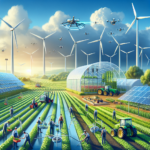-
Table of Contents
- Introduction
- The Circular Economy in Indonesia
- Understanding the Circular Economy
- Challenges and Opportunities in Indonesia
- Kontribusi Teknologi Hijau terhadap Ekonomi Sirkular
- 1. Waste Management and Recycling Technologies
- 2. Renewable Energy Technologies
- 3. Sustainable Agriculture Technologies
- 4. Circular Design and Manufacturing
- Conclusion
Introduction

The concept of a circular economy has gained significant attention in recent years as a sustainable alternative to the traditional linear economy. In a circular economy, resources are used efficiently, waste is minimized, and products are designed to be reused or recycled. This approach not only benefits the environment but also has the potential to contribute to economic growth. In Indonesia, the adoption of green technologies is playing a crucial role in driving the transition towards a circular economy. This article explores the contributions of green technologies to the circular economy in Indonesia.
The Circular Economy in Indonesia
Understanding the Circular Economy
The circular economy is a system that aims to keep resources in use for as long as possible, extracting maximum value from them while minimizing waste and pollution. It is a departure from the traditional linear economy, which follows a “take-make-dispose” model. In a circular economy, products are designed to be durable, repairable, and recyclable, and materials are kept in circulation through recycling and reusing.
Challenges and Opportunities in Indonesia
Indonesia, as a developing country with a rapidly growing population and economy, faces numerous challenges in transitioning to a circular economy. The country struggles with waste management, with a significant portion of waste ending up in landfills or polluting the environment. However, these challenges also present opportunities for innovation and the adoption of green technologies.
Kontribusi Teknologi Hijau terhadap Ekonomi Sirkular
1. Waste Management and Recycling Technologies
One of the key contributions of green technologies to the circular economy in Indonesia is in the field of waste management and recycling. Advanced waste sorting and recycling technologies enable the recovery of valuable materials from waste streams, reducing the need for virgin resources. These technologies include automated sorting systems, composting machines, and plastic recycling plants. By implementing these technologies, Indonesia can reduce its reliance on raw materials and create a more sustainable and efficient waste management system.
2. Renewable Energy Technologies
Another significant contribution of green technologies to the circular economy is in the area of renewable energy. Indonesia has abundant renewable energy resources, including solar, wind, and geothermal. By harnessing these resources through the deployment of solar panels, wind turbines, and geothermal power plants, Indonesia can reduce its dependence on fossil fuels and promote a more sustainable energy system. The integration of renewable energy into the circular economy also creates opportunities for job creation and economic growth.
3. Sustainable Agriculture Technologies
Agriculture is a vital sector in Indonesia, and the adoption of sustainable agriculture technologies can contribute to the circular economy. Green technologies such as precision farming, hydroponics, and organic farming practices can improve resource efficiency, reduce chemical inputs, and minimize waste in the agricultural sector. These technologies not only promote environmental sustainability but also enhance the productivity and profitability of farmers, contributing to economic growth.
4. Circular Design and Manufacturing
Circular design and manufacturing practices are essential for achieving a circular economy. Green technologies enable the development of products that are designed for durability, repairability, and recyclability. Advanced manufacturing technologies, such as 3D printing and additive manufacturing, allow for the production of customized products with minimal waste. By embracing circular design and manufacturing, Indonesia can reduce resource consumption, extend product lifecycles, and create new business opportunities.
Conclusion
The adoption of green technologies is crucial for Indonesia’s transition towards a circular economy. Waste management and recycling technologies, renewable energy technologies, sustainable agriculture technologies, and circular design and manufacturing practices all contribute to the efficient use of resources, waste reduction, and economic growth. By embracing these technologies, Indonesia can not only address environmental challenges but also create new business opportunities and improve the well-being of its citizens. The government, private sector, and civil society must work together to promote the adoption and implementation of green technologies to realize the full potential of the circular economy in Indonesia.





